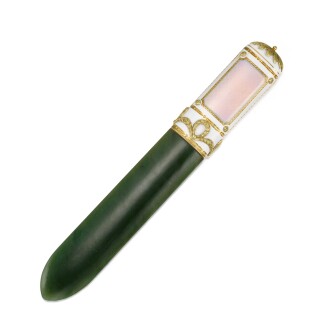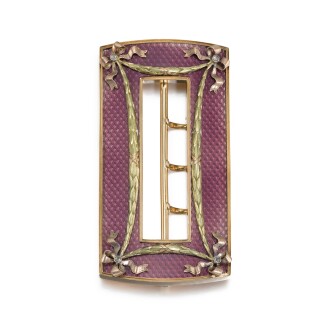S
otheby’s spring edition of Gold Boxes, Fabergé and Objects of Vertu covers around two and a half centuries of craftmanship to be admired in a great variety of gold boxes from several private collections. The first, a carefully-curated collection of gold boxes ranging from the mid-18th to the mid-19th century (lots 1-30), offers a ravishing insight to the variety of techniques and styles that emerged in the category over the course of a century. From early multicoloured gold tabatières made in Paris (lot 1,2) to intricately inlaid piqué examples in extraordinary shapes (lot 8,9) and a lacquer example from the Goldschmidt-Rothschild collection (lot 4), this private collection also features rare enamels, such as the late 18th century ‘history painting’ snuff box from Geneva (lot 16) and brightly-enamelled gold boxes with a surprisingly contemporary feel (lot 15). Long overlooked, a tour de force of German chasing from Hanau (lots 5, 18) is represented alongside diamond-set royal presentation boxes (lots 28, 29, 33-36).
The second group of boxes from a private Italian collector, equally assembled over the course of decades, focuses on all different types of enamels, led by a rare and museum-quality example by the London jeweller James Morisset (lot 55), most of whose work is located in international museums (lot 55). Taille d’épargne, paillon and en plein enamelling from Geneva, Paris and Germany (lots 56, 57, 64, 67, 74) show the richness of the medium and the inventiveness of the 18th century bijoutiers, even including musical automata (lot 70). One of the highlights of the hardstone section is a charming Roman micromosaic plaque mounted in porphyry (lot 41), spreading its wings just a little bit wider than the fanciful singing bird concealed in an early 19th century gold box made by Rémond in Geneva in the 19th century (lot 42).
The sale also includes over fifty works by the iconic firm of Fabergé (lots 95 – 148), ranging from expertly enamelled clocks to delicate Fabergé jewels. Led by a rare Fabergé desk clock from a European Collection (lot 102) and encompassing wonderfully carved hardstone objects such as a hippo originally in the collection of Princess Maria Sergeevna Koudacheff (lot 96), the sale highlights the enamelled, jewelled, lapidary and silver works that made Fabergé the most important jewellery firm of its time.
Auction Highlights

Bonbonnières and the Meanings of a ‘Sweet Tooth’ in The 18th Century
Originating in the Royal French court in the 17th century, the fashion of bonbons, often served at special occasions, had spread all over Europe by the mid-18th century. These small chocolate confections containing liqueur, fruit, nougat covered in chocolate, and today often wrapped individually in brightly-coloured foil, were made in all sorts of different shapes and from different flavours in the 18th century. Deriving from the reduplication of the French adjective bon, these small sweet and sugary pick-me-ups were served in richly decorated containers such as nefs or coupes, often made form Silver or carved from hardstones. Smaller lidded containers, usually brightly-enamelled or classically decorated, were intended to be carried in one’s pockets long before individually wrapped confectioneries were available. The earliest types of these gold containers became known as drageoirs (derived from the French dragée, a sugary confectionary with a hard outer shell). A little later in the second half of the 18th century, these gold-lined and often circular containers without a hinged lid that were made by Parisian, Genevois, London or German bijoutiers became known as bonbonnières. Until today, these luxurious sweetmeat or bonbon containers, enamelled in pastel colours, set with pearls or decorated with micromosaic butterflies, have lost none of their fascination despite their obvious change in initial function.

The Golden Days – ‘Snuff’ and its Splendorous Containers Since The 18th Century
‘Two hundred years ago the gentleman who plunged his hand deep into a voluminous pocket and brought out his latest box, with an elaborate armoury of appropriate gestures and finger movements, did so secure in the easy assurance of his own superb and unerring connoisseurship, and could nonchalantly observe the splendid effect his performance of the snuffing ceremony was producing on his enraptured friends’. Such ‘unerring connoisseurship’, as described by the late Kenneth Snowman (1966), naturally did not only apply to the ritual of taking snuff itself, but much more so to the container in which the scented tobacco mixed with oil was kept by the most fashionable members of society during the 18th century. One’s great taste and social status was expressed by carefully choosing a specific gold box by the most renowned maker of each period, featuring certain materials (tortoiseshell, lacquer, hardstone, mother of pearl), techniques (engraving, chasing, enamelling) and designs that were ever evolving alongside fashion developments, with trends initially set in the trailblazing capital of Paris.
After snuff-taking and the rituals and circumstances surrounding it had become the most common topic of conversation and satire in the eighteenth century, the gold boxes to hold them had begun to obtain a different purpose in the following century. Diamond-set diplomatic gifts of gratitude, intimate gifts among lovers set with portrait miniatures of the beloved one, conveyors of political orientation with concealed compartments, or mechanical marvels of utmost technical complexity were on the rise. As luxurious three-dimensional objects with a practical function, the enormous variety of the category of gold boxes does therefore not only represent the extraordinary craftmanship, technical progress and inventiveness of the goldsmiths more than two centuries ago, but also offers us a glimpse of society and taste of an opulent, intellectually fuelled and certainly golden bygone era.

The Artistry of Fabergé Lapidaries
With the rich resources of the Ural Mountains at his fingertips, Carl Fabergé’s creation of artworks in hardstone grew increasingly popular – eventually prompting him to open his own workshop, rather than outsource carving to other lapidaries such as Woerffel, Stern and Oberstein. Famous for his pursuit of perfection, this allowed Fabergé to directly supervise the quality of the cutting of stones, seamlessly coordinating them with the gold-chasing and jewelled mounts that would hold and adorn them. With the increased quality of lapidary work, workmasters were able to achieve new colour combinations, textures and sculptural effects which encouraged them to place lapidary works at the fore of production. The most common minerals sourced by the firm for a variety of designs were nephrite, rhodonite, jasper, quartz, serpentine, lapis lazuli, rock crystal, straited agate, turquoise, obsidian, bowenite and semi-precious stones such as amethyst, aquamarine, garnets, topaz and citrine.

Fabergé Innovations in Enamel
Having spent his apprenticeship travelling to Dresden, Frankfurt, Florence and Paris, as well as studying objects of vertu in the rich stores of the Hermitage’s jewellery gallery, Carl Fabergé’s formative designs relied greatly on the historical Louis XV and Louis XVI style - reinterpreting them in his own highly creative vernacular. The innovation of a new and extraordinary range of enamel colours and guilloché techniques, including enamelling en ronde bosse (in the round), so famously exhibited in the Imperial Easter eggs and so notoriously hard to achieve, lies at the heart of Fabergé’s production. Drawing on a palette of over 144 different shades, the workshops of Fabergé perfected the historical French styles that Fabergé studied so closely and introduced an unprecedented range of colour into his works, inspiring competing jewellery firms such as Cartier to do the same.









































